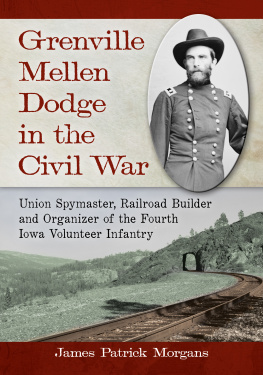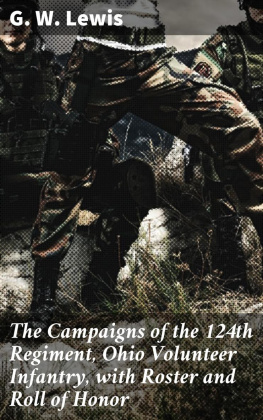2002 by The Kent State University Press, Kent, Ohio 44242
All rights reserved
Library of Congress Catalog Card Number 2001003956
ISBN 0-87338-729-5
Manufactured in the United States of America
06 05 04 03 02 5 4 3 2 1
Library of Congress Cataloging-in-Publication Data
Pope, Thomas E., 1963-
The Weary Boys : Colonel J. Warren Keifer and the 110th Ohio Volunteer Infantry /Thomas E. Pope
p. cm.
Includes bibliographical references and index.
ISBN 0-87338-729-5 (pbk. : alk. paper)
i. United StatesArmyOhio Infantry Regiment, 110th (1862-1865) 2. OhioHistory Civil War, 1861-1865Regimental histories. 3. United StatesHistoryCivil War, 1865-1865Regimental histories. 4. Keifer, Joseph Warren, 1836-1932. 5. OhioHistoryCivil War, 1861-1865Social aspects. 6. United StatesHistoryCivil War, 1861-1865Social aspects. I. Title
E525.5 110th.P66 2002
973.74771dc21
2001003956
British Library Cataloging-in-Publication data are available.
As an adolescent, I visited my grandparents and looked through many of their prized possessions. Several items remain in the forefront of my memory: a diary, a captains log, and a medal. During those visits, I spent many hours pouring over the diary and log, and I was thoroughly intrigued by the information contained in those treasured items. My ancestor, John McColley, faithfully recorded his business transactions and daily occurrences for many decades. It was this initial exposure to primary-source material that started my journey into historical research.
In a walnut display case handcrafted by my grandfather, my grandparents kept several items of sentimental value. I was always drawn to one in particular that was prominently displayed there, my great-great-grandfathers Grand Army of the Republic medal. Like any inquisitive youngster, I questioned my grandmother about this fantastic artifact, and she proudly proclaimed that it was her grandfathers Civil War medal.
On subsequent visits, I was continually drawn to these wonderful treasures. With a desire for more information, I questioned my father about the medal. Being a former social studies teacher, he began telling me stories about the Civil War. Then, while in junior high school, I continued my quest for more knowledge about the war and how my ancestor fit into it. My father quickly suggested that I read some Civil War books that he had, handing me Bruce Cattons classic works. I was hooked.
Shortly after beginning my teaching career at Graham High School in St. Paris, Ohio, I entered graduate school at Wright State University and chose the thesis track. Early on, I decided to research and write a regimental history. I discovered that a local regiment, the 66th Ohio Infantry, did not have a written unit history. I spent a year conducting preliminary research and was just beginning to search for primary sources when I discovered that another historian was much further along in his 66th Ohio research. After consulting with my thesis director, Dr. Edward Haas, I scrapped the project. I then jotted down information on several other local regiments and began preliminary research. As my notes mounted, I discovered that the 110th Ohio Volunteer Infantry, an organization that had seen significant action, did not have a regimental history. I also found that its colonel became a lesser known, but undoubtedly significant, figure in the Republican party.
While researching the regiment, I learned that the 110th and the rest of the Second Brigade, Third Division, Sixth Army Corps, were, in fact, the organizations that had been derisively named Milroys Weary Boys. In the aftermath of the Second Battle of Winchester, Maj. Gen. Robert Milroys division had run from a numerically superior Confederate force. When the divisions remnants were consolidated and assigned to the Army of the Potomac, the 110th was not universally accepted. Many Eastern Theater veterans shunned the newcomers, and Maj. Gen. Winfield Scott Hancock gave the 110th Ohio their epithet.
Many modern historians have perpetuated the inaccurate portrayal of this regiment and its brigade. I used this misnomer in the books title because I firmly believe that the nickname should be viewed in a completely different light. Rather than accept the shame usually associated with Milroys Weary Boys, I believe that the 110th Ohio Volunteer Infantry should wear the epithet with honor. The 110th performed admirably during its service, and on many occasions the regiment excelled where many others would have failed. In fact, Ohio contributed approximately 175 regiments of infantry and cavalry to the Union armies, with only fifteen Ohio regiments suffering more than one hundred battle deaths. Col. J. Warren Keifers Weary Boys is among this honored group.
When I began, I envisioned this book as being strictly a military history. Then, as I delved into the letters and diaries of the soldiers, I became enthralled with the human aspect and the social history. I especially enjoyed the descriptions used by the soldiers regarding the drudgery of camp life and when their emotions poured forth in postcombat writings. Whenever possible, I maintained the soldiers exact spellings and phrasings.
As I searched and found the primary sources necessary for this study, I encountered many helpful people. I consulted many of my former colleagues at Graham High School. Many of them proofread material, and I solicited their advice on various other ideas. I must thank Mike Apswisch, Kelly Braun, Melissa Brandewie, Rich Dickert, Larry Moore, Rich Randall, Jack Wood, and the rest of the Graham High School staff for their time, patience, and encouragement. Floyd Barman, Heather Turner, and Virginia Weygandt of the Clark County Historical Society, Springfield, Ohio, were wonderful. I greatly appreciate the help, advice, and additional privileges they granted me. Nan Card and the staff at the Hayes Presidential Library, Fremont, Ohio, were of great service. Gary Arnold, archives specialist at the Ohio Historical Society helped locate many sources.
My friend and author of A Light and Uncertain Hold, the late David T. Thackery, gave me wonderful advice and pointed me to many sources. I sorely miss our conversations and discussions. Jim Oda, the Piqua history coordinator; the staff of the Greene County Room, Xenia, Ohio; and many others contributed greatly to this endeavor. Dr. Carl Becker and Dr. Barbara Green, both of Wright State University, offered much advice. Roger Long of Port Clinton, Ohio, made significant commentary on the final draft. I must also thank Mrs. Sue Frary of Cincinnati, Ohio, and Mr. Robert G. Hill of Sidney, Ohio, for letting me use the letters and diaries in their possession. Rick Pope did a fantastic job creating maps. John Hubbell, Joanna Hildebrand Craig, Erin Holman, Perry Sundberg, Christine Brooks, and the rest of the Kent State University Press staff were especially patient with me. They readily answered the many questions that I had and they offered excellent advice throughout the manuscript process.


 Thomas E. Pope
Thomas E. Pope Kent & London
Kent & London

